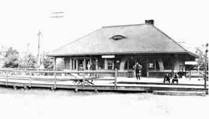|
North Penn Railroad line's Perkasie engine (above and below right) |
BEGINNINGS IN PERKASIE
|
|
North Penn Railroad line's Perkasie engine (above and below right) |
BEGINNINGS IN PERKASIE
|
|
TRAIN BEGINNINGS In 1853 the Northern Pennsylvania railroad decided to extend their railroad line from Fort Washington, PA to Bethlehem, PA. At that time Perkasie consisted of four small family farms. The high ground above town (the Ridge) was a major obstacle; in June 1853 the construction of a tunnel began (near what is today 9th & Vine Streets). For three years a half mile of solid rock was worked by hundreds of men with picks, shovels, and gunpowder. Soon known as the Perkasie Tunnel it was considered a marvel in its day. |
|
By 1858 the North Penn Branch of the North Pennsylvania Railroad was completed through Bethlehem. At that time there was not a house of any kind at what was known as Perkasie in 1891.
|
The water house above is from nearby East Rockhill, PA. Note steam at right. |
In 1871 there was a single track for the rail road traffic. There were no switches in Perkasie except for the lumber track and no water house (for steam engines). . A water house was placed in Perkasie on 8th Street near the Perkasie station (heading toward Sellersville). No trace of the Perkasie water station remains today. |
In 1871 one of four passenger trains on the line stopped on the way from Bethlehem to Philadelphia for the three hour trip.
In 1885 rails weighing 68 pounds to the yard were purchased for $28 per ton for the purpose of doubling the track on the North Pennsylvania Railway from Philadelphia to Bethlehem. The track was completed by January of 1886.
TRAIN STATION
 |
|
|
| Perkasie Railroad Station as viewed from 8th street on the rail side. | Perkasie Railroad Station viewed from 7th Street near Chestnut Street. |
The station began in the Hendricks building. An overcrowded wooden station was built and was moved across the tracks in 1892 when it became the freight depot. A brick and stone structure had ladies and gents waiting rooms, toilet rooms, express room and a ticket room. A portecochere (covered carriage entrance) for the convenience of carriages lead to a broad stairway to the depot. The building was heated and featured extensive plumbing. During the same year the train station was built and was considered the finest along the line.
Today, most multi-state passenger trains are used by Amtrack, Inc. In the Philadelphia area, Conrail controls most of the local passenger trains. Currently, only one train runs through Perkasie. The remaining train carries cargo to other locations throughout the state and country.
Conrail trains in the 1970's when passenger lines still ran through Perkasie |